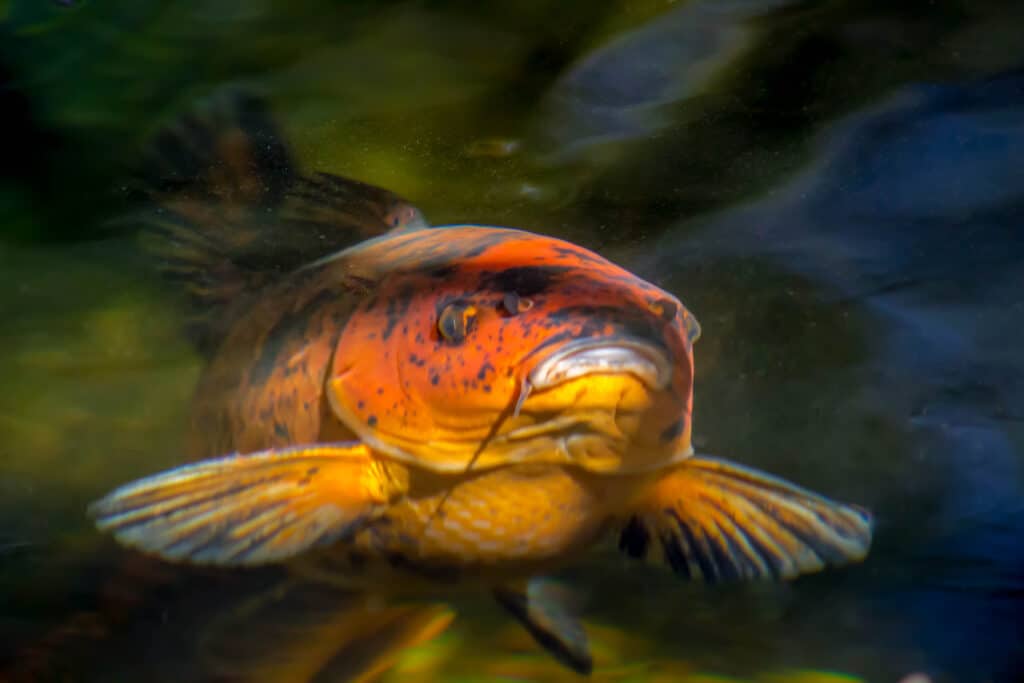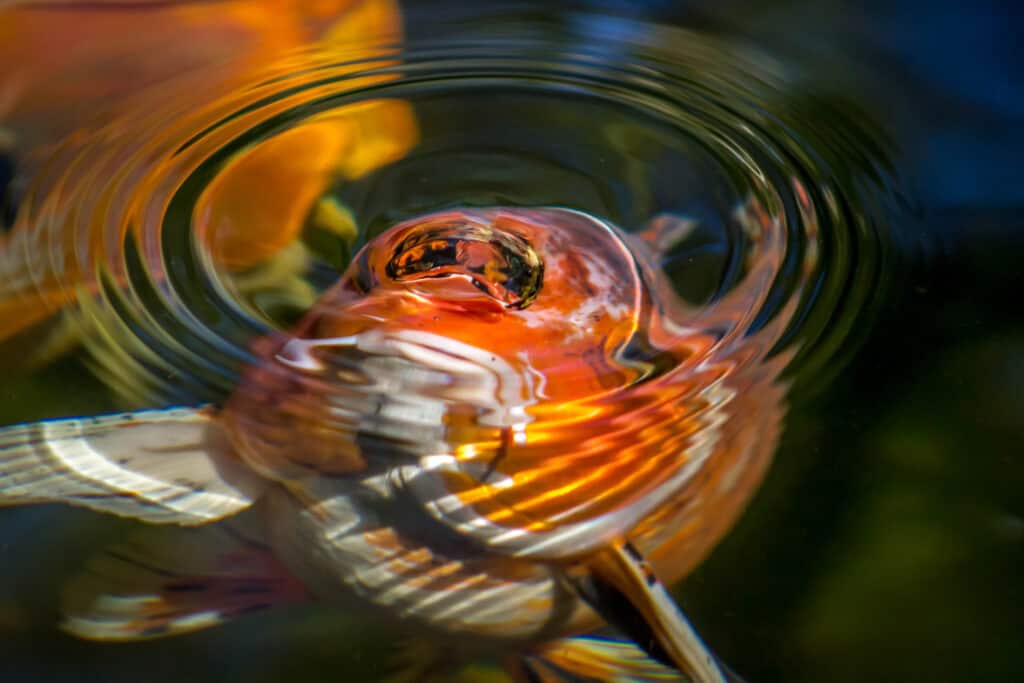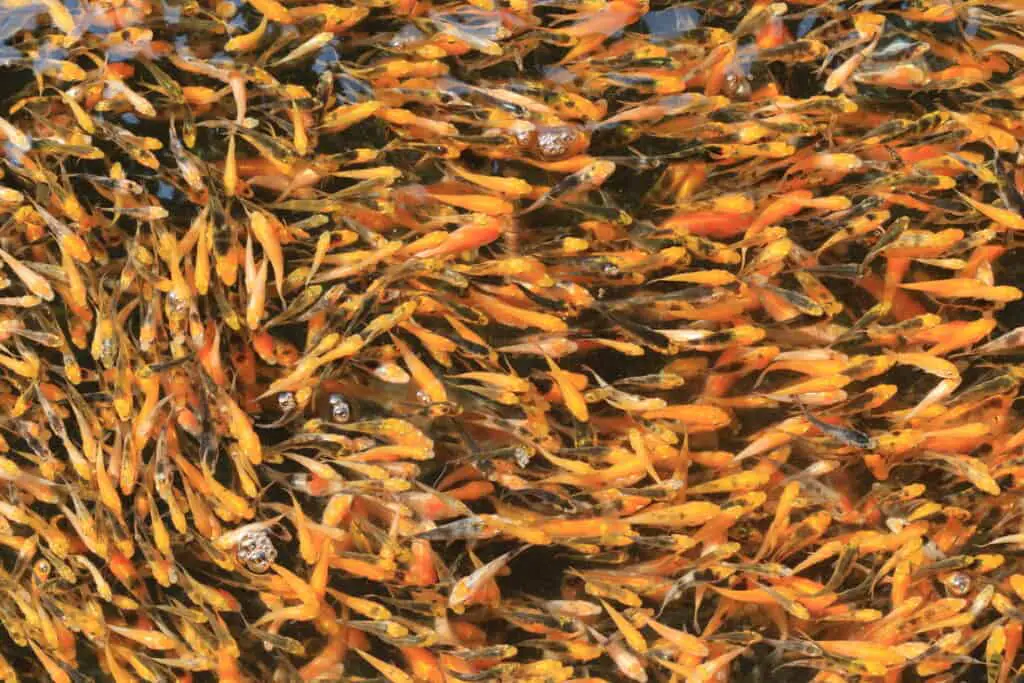
Few things elevate an outdoor setting more than a beautiful koi pond. Most of us have only seen these magnificent fish in their spectacular adult form as they glide around gracefully, adding stunning dashes of color and movement to the water. So you may have wondered where baby koi come from. Do they lay eggs or give birth to live young?
Koi lay eggs in a process called spawning. Females release a large number of eggs which are scattered over an extensive area of the pond. Males repeatedly nudge and bump females to stimulate the release of eggs and immediately fertilize them; eggs hatch in four to five days.
This may sound straightforward, but there is more to breeding koi than meets the eye. In addition, the newly-hatched fry is an easy meal for other fish, including their parents! Let’s find out more about the life cycle of these beautiful ornamental fish.
Do Koi Lay Eggs Or Live Birth?

Koi do not give birth to live fry but instead reproduce by a process called spawning. This means that many eggs are produced and deposited around the pond. Eggs are sticky and readily attach to the first surface they encounter.
Healthy female fish of the right age spawn annually when daylight hours become longer and the water temperature remains consistently above 65F. This usually occurs when the weather warms up in late spring or early summer.
Most types of koi reach sexual maturity at around three to four years of age. Interestingly, although these fish can have impressive lifespans and can easily live into their fifties, their breeding seasons are limited to between the ages of three and seven.
The actual process leading up to spawning and the eventual development of hatchlings takes place in stages.
- The development of eggs inside the female – It takes a full year for the eggs inside the female koi to develop and be ready to release when warmer temperatures arrive. So the eggs spawned have been a year in progress inside the female. The eggs that the female produces are not fertilized.
- Pre-Spawning Conditions – Spawning behavior is triggered by rising temperatures and longer daylight hours. The female fish will begin to exhibit a visibly swollen abdominal area, drawing the attention of sexually mature males.
- Spawning Behavior – Once the female’s abdomen becomes round, it signals that the eggs are ready to be fertilized. Sexually mature males will begin to pursue her relentlessly around the pond. Nudging and bumping into the female’s sides and stomach area helps stimulate the release of eggs quickly fertilized by the males as soon as they are released.
If the pond contains many koi, this process can become quite violent, with multiple male fish smashing into the female to get her to spawn.
- Post Spawning – Koi eggs are sticky and readily stick to any surface they land on. Fertilized eggs will appear translucent and may have a tiny dark dot inside. Unfertilized eggs will quickly turn white. It is a good idea either remove the adults or the eggs to a different pond so the hatchlings have the best chance of survival.
- Hatching – If water conditions are favorable, a tiny translucent fry will hatch from fertilized eggs in 4 to 7 days. These fragile little creatures use their remaining yolk sac to get through their first few days of life and try to stay as undetected as possible.
How Many Eggs Do Koi Lay?
The quantity of eggs produced by a female koi during a breeding season depends on its weight. For every 1 pound of weight, a female can lay 50 000 eggs. Therefore breeders closely monitor the weight of their fish and can estimate the number of eggs that will be produced in a season reasonably accurately.
Although this may seem like a massive number of baby koi, only about 60% of the eggs produced are likely to hatch. On top of that, tiny fry are quick snacks for all hungry predators, so making it to adulthood is a feat in itself for a koi.
Most breeders remove the adults from the pond after spawning or remove the eggs and place them in a separate nursery tank. The simplest method is to provide a hatching rope or mop, which is a handy egg-catching surface. Pop the rope into the water ahead of the spawning. It can easily be removed and placed into a nursery tank where your hatchlings can thrive without fear of being eaten.
Baby koi, called fry, will hatch from eggs four to five days after they were somewhat haphazardly scattered over the bottom of the pond. They are tiny, translucent little creatures that prefer the safety of well-planted spots near the bottom of the pond.
How To Care For Baby Koi

The most critical factor in successfully raising newly hatched koi is keeping them safe from predators. Even though sexually mature koi spawn an immense number of eggs each season, the eggs and the hatchlings are on the menu for everything from other fish, tadpoles, and even their parents.
Eggs can be removed from the pond to a nursery tank before hatching, or the adults can be moved. Provide plenty of places for hatchlings to take cover. If you have plants in your tank, you will notice fry gathering around the stems and base. Special spawning mops are available that newly hatched fry will attach to as they instinctively try to hide.
Koi don’t need to be fed for the first two or three days after hatching. They survive off the nutrients in their egg sac. Although they have hatched, they have no mouth, vent, or swim bladder and instinctively seek out a protected position, usually the sidewalls of the pond, where they will attach themselves securely.
Provision of sufficient oxygen to hatchlings is essential. The fry absorbs oxygen through the fine capillaries around the egg sac. They do not yet have a mouth or other organs but need an ample supply of oxygen in the water. Ensure that air stones in the tank work optimally to give developing koi hatchlings the best chance of survival.
After two or three days, the baby koi will start swimming. They develop fins and other organs, enabling them to become more independent and move around in the tank. The first place they visit is the surface so they can gulp some air into their newly formed swim bladder. This will enable them to swim around easily.
At this stage, the fry should be offered food for the first time. There are specific liquid fry food formulations available that should be given in small amounts several times a day. In addition, strained hard-boiled egg yolk is a nutritious extra.
After two weeks, the koi fry will be able to graduate onto powdered fry food. In addition, tiny protein-laden snacks like shrimp larvae can be included. The important thing is that the food offered must always be small enough for the fry to consume. For healthy growth, the food must also be protein-rich.
How Can You Tell If A Koi Fish Is Pregnant?

If you notice that your female koi seems a bit rounder than usual, you may start excitedly planning for koi babies. However, there are many steps to this anticipated outcome, and conditions need to be suitable for it to lay the eggs, for them to hatch, and for the tiny koi to survive.
Remember that koi do not give birth to live infants, so while the female fish may contain eggs, they are not fertilized. When they are the right age and conditions in the water are ideal, female koi will spawn eggs that need to be immediately fertilized by an accompanying male or two. Koi eggs on their own without males in a pond will not be viable.
Keep in mind that a swollen abdomen in a koi may result from a health issue like dropsy or a tumor, and not necessarily because it is full of eggs. To identify a pregnant koi, one first needs to confirm the following factors:
- Is the fish female? – When they are young, it can be tough to tell the difference between the sexes. As they reach sexual maturity, it becomes easier to tell males and female koi apart. You can check here to find the differences between male and female koi.
- Is your female koi old enough to spawn? Koi only breed from around year 3 to year 7 of their entire lives. If your koi is too young or too old to breed, the chances are that it does not contain eggs. A female must be at least 10 inches long to have fully developed reproductive organs, so if your koi are smaller, your fish cannot yet lay eggs.
- Is it the correct time of year? – Koi fish spawn in response to the amount of light and an optimum water temperature being achieved and maintained. These fish typically spawn when water temperatures are 65F – 70F in late spring or early summer.
If you have ticked yes to all these conditions, and your koi looks bloated, it is likely getting ready to spawn. The pregnant fish’s abdomen will have a bumpy appearance, almost like it is filled with tiny marbles.
Increase the percentage of protein you are feeding to support the healthy development of the eggs. Female koi often get injured while spawning if there are too many males enthusiastically bumping and pushing them. Try to reduce the ratio of males per female to two.
Ensure that the males you keep with the female are of reproductive age. Provide a spawning rope or mop to catch and protect eggs as they are produced so that you can easily remove them or place them in safer waters.
How Do Koi Mate?
If your pond has male and female koi of reproductive age, spawning will occur spontaneously when the amount of daylight and water temperature is correct. Eggs laid by the female are fertilized outside her body. The process of laying eggs is called spawning, and up to a million eggs can be produced by a mature female in a season.
When females are ready to spawn, their abdomens appear swollen and lumpy. Usually, docile male fish will become agitated and aggressively begin to chase females. If you have too many males in a pond per female, it can become dangerous as multiple males continuously smash into the female and try to get her to drop her eggs.
The best situation is to have two interested males per female koi. This way, they can swim alongside and nudge the swollen abdomen from both sides. Male fish repeatedly bump female fish with their heads or fins to encourage them to release the eggs.
Females usually head for shallower water or areas with more vegetation when she is about to lay. Eggs are dropped in a scatter pattern in a pond, and male koi spray them with sperm as they are released. The eggs stick to the first surface that they encounter. Pond owners may notice changes in the water during this process, making it appear foamy or cloudy.
When they are spawned, eggs become an easy snack for everything in a pond. Koi keepers should therefore take precautions to ensure that eggs and hatchlings have protected areas or are even entirely removed from the pond. Fertilized eggs will hatch in four to five days.
Conclusion
Koi fish don’t give birth to live young; They lay eggs in a process referred to as spawning. Male koi fish swim alongside a female when it is ready to spawn and repeatedly nudge and bump her to encourage the release of eggs. As soon as they leave her body, the males cover them in sperm. Fertilized eggs that do not become food for predators will hatch four to five days after being laid.
References:
https://www.cuteness.com/article/how-koi-fish-give-birth
https://en.wikipedia.org/wiki/Koi
http://www.aquaticcommunity.com/goldfish/breedingkoi.php
https://sciencing.com/do-fish-reproduce-freshwater-ponds-6630942.html
https://animals.mom.com/how-to-raise-baby-koi-after-they-are-born-12522532.html


